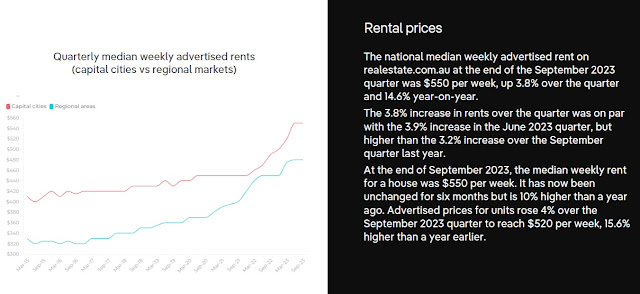Inflation 1.2 per cent
Inflation came in at 1.2 per cent for the September quarter, a bit higher than the median market expectation of 1.1 per cent.
The trimmed mean reading also came in at 1.2 per cent for the quarter, slightly above market expectations.
Over the year the inflation rate has slowed from 7.8 per cent to 5.4 per cent, and with another large print to drop off the annual reading next quarter we'll be down to about 4½ per cent or a bit below that by the end of 2023.
Source: ABS
So, it's seemingly going to take a bit longer than previously hoped to see inflation falling back to the target range, and this led to many economists upgrading their calls to incorporate another interest rate hike on Melbourne Cup Day to a cash rate target of 4.35 per cent.
Others, including Deloitte Access Economics, Stephen Koukoulas of Market Economics, and
Terry McCrann in The Australian, have argued strongly for no jumping at shadows, and for taking a more anguine approach of interest rates to stay on hold until next year.
Until yesterday, Westpac saw the next move in interest rates as being down, but haven't yet updated their call.
The inflation in the September quarter was largely driven by international pressures driving higher fuel prices, and domestically by housing costs (i.e. rents and new dwelling costs), and electricity prices.
We do know that many developers are teetering on the precipice of extinction and that further tightening would almost certainly kill off another swathe of construction businesses.
This would arguably make the rental market pressures worse than they already are.
Indeed, capital city rental listings have declined to their lowest level on record this month,
The real elephant in the room here is that immigration is now running at an annualised pace of around 550,000 per annum, fueling population growth of around 2,000 per day in Australia.
Source: Shane Oliver, AMP
New dwelling costs have been a huge contributor to inflation through this cycle and the HomeBuilder stimulus package, but thankfully cost pressures here are reportedly now easing in real time (despite the more modest increase of +1.3 per cent this quarter).
Source: ABS
Voters should justifiably be angry about electricity costs, which would be around 30 per cent higher over the year were it not for government subsidies.
Lower energy prices were a key election pledge, and we can't so easily blame this surge in prices on external factors.
---
Market reaction
Overall, this was a stronger than expected inflation print, although the higher fuel prices were largely driven by international issues, and will themselves act as an effective 'hike' on households spending in due course.
The Aussie dollar initially kicked up a bit on the news, before later trading all the way back down from whence it came, to finish the day lower than where it started.
Looking further out, Australia's 3-year bond yield is quietly retesting the highs seen back in early July.
What next?
What happens to housing if we get a further interest rate hike in November on Melbourne Cup day?
An ongoing rise in mortgage arrears, certainly, and more developers doubtless fall over as a result of worsening cashflows combined with a further hit to confidence.
Dwelling prices in many regional parts of the country will likely also take a further step down towards reality.
Housing supply is already struggling to keep pace with population growth, and a further interest rate hike wouldn't help here.
The rental crisis most likely worsens as a result, as well as leading more landlord owners to selling up.
Borrowing capacities may also be set to take a further hit, pushing more buyers into lower price points, and in Sydney and Brisbane more buyers will be pushed from looking at houses into units.
There's still a fair amount of monetary tightening in the pipeline, as fixed rate mortgages continue to reset.





















































